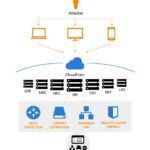In the vast and ever-evolving landscape of technology, the task of migrating billions of records from one database to another is no small feat. Now imagine doing so while that database is actively in use, serving countless users around the clock. This article will delve into the intricate process of seamlessly moving our active DNS database, showcasing the challenges, strategies, and innovations required to execute such a monumental task. Join us on this journey as we navigate the complexities of data migration in real time.
Table of Contents
- Challenges of migrating a live DNS database
- Strategies for minimizing downtime during migration
- Best practices for ensuring data integrity during the migration process
- Considerations for successfully transferring billions of records in a live environment
- Q&A
- The Way Forward

Challenges of migrating a live DNS database
Moving a live DNS database with billions of active records presents a unique set of challenges that require careful planning and execution. One of the main hurdles is ensuring minimal downtime during the migration process to avoid disrupting services for users. This involves coordinating with multiple teams, implementing proper testing procedures, and having contingency plans in place in case of unexpected issues.
Another challenge is maintaining data integrity throughout the migration process. Ensuring that all records are accurately transferred to the new database without any loss or corruption requires meticulous attention to detail. This involves verifying data consistency, performing thorough checks, and conducting extensive testing to confirm that the migration is successful. With proper planning and execution, these challenges can be overcome to successfully migrate a live DNS database without impacting services.
Strategies for minimizing downtime during migration
One key strategy for minimizing downtime during the migration of billions of records in our active DNS database is to schedule the migration during off-peak hours. By choosing a time when traffic is at its lowest, we can ensure that the impact on users is minimal. Additionally, performing a thorough analysis of the database beforehand can help identify any potential issues that may arise during the migration process, allowing us to proactively address them and prevent unexpected downtime.
Another effective strategy is to utilize a reliable backup and recovery solution throughout the migration process. With a backup in place, we can easily revert to the previous database if any issues occur during the migration. Additionally, testing the migration process multiple times in a test environment before executing it on the live database can help uncover any potential issues and ensure a smooth transition with minimal downtime for our users.

Best practices for ensuring data integrity during the migration process
When migrating billions of records from one server to another, ensuring data integrity is paramount. In the case of moving an active DNS database while it’s in use, there are several best practices that can help minimize the risk of data corruption or loss.
One key approach is to conduct thorough testing before the migration process begins. This involves running simulations to identify any potential issues that may arise during the actual migration. Additionally, implementing a robust backup strategy is essential in case of any unforeseen data discrepancies. During the migration process, monitoring the data transfer closely and regularly verifying the integrity of the records can help mitigate risks. By following these best practices, organizations can successfully migrate their active DNS database while maintaining data integrity.

Considerations for successfully transferring billions of records in a live environment
When transferring billions of records in a live environment, there are several key considerations to keep in mind to ensure a successful migration process. One important factor to consider is the impact on performance during the transfer. It’s essential to plan for potential disruptions and allocate enough resources to minimize downtime.
Another crucial aspect to consider is data integrity. Ensuring that all records are accurately transferred without any loss or corruption is vital. Implementing rigorous testing procedures and monitoring tools can help mitigate risks and ensure a smooth transition. Additionally, communication with stakeholders and users about the migration plan and potential impacts is crucial for a successful transfer.
Q&A
Q: Why is migrating a DNS database challenging?
A: Migrating a DNS database is challenging because it involves moving billions of records while the system is still in use, without causing disruptions to users.
Q: What are some factors to consider when migrating a DNS database?
A: Factors to consider when migrating a DNS database include ensuring data integrity, minimizing downtime, managing traffic spikes, and maintaining the security of the system.
Q: How do you migrate a DNS database while it’s still in use?
A: Migrating a DNS database while it’s still in use requires careful planning, coordination, and communication with stakeholders. It often involves using tools and techniques to replicate data, test changes, and gradually transition traffic to the new system.
Q: What are some best practices for migrating a DNS database?
A: Best practices for migrating a DNS database include conducting thorough testing, communicating with users about potential disruptions, monitoring the migration process closely, and having a rollback plan in case of unforeseen issues.
Q: What are the benefits of successfully migrating a DNS database?
A: Successfully migrating a DNS database can lead to improved performance, increased reliability, and better scalability of the system. It can also help organizations adapt to changing business needs and technological advancements.
The Way Forward
the migration of billions of records in our active DNS database while it’s in use was a complex and challenging task that required careful planning and execution. By leveraging innovative technologies and strategies, we were able to successfully transfer the data without any disruption to our services. As we continue to evolve and grow, we are committed to maintaining the highest standards of reliability and performance for our users. Thank you for following along on this journey. Stay tuned for more exciting updates in the world of DNS management.











Neque porro quisquam est, qui dolorem ipsum quia dolor sit amet, consectetur, adipisci velit, sed quia non numquam eius modi tempora incidunt ut labore.
Quis autem vel eum iure reprehenderit qui in ea voluptate velit esse quam nihil.
Et harum quidem rerum facilis est et expedita distinctio. Nam libero tempore, cum soluta nobis est eligendi optio cumque nihil impedit quo minus id quod maxime placeat facere.